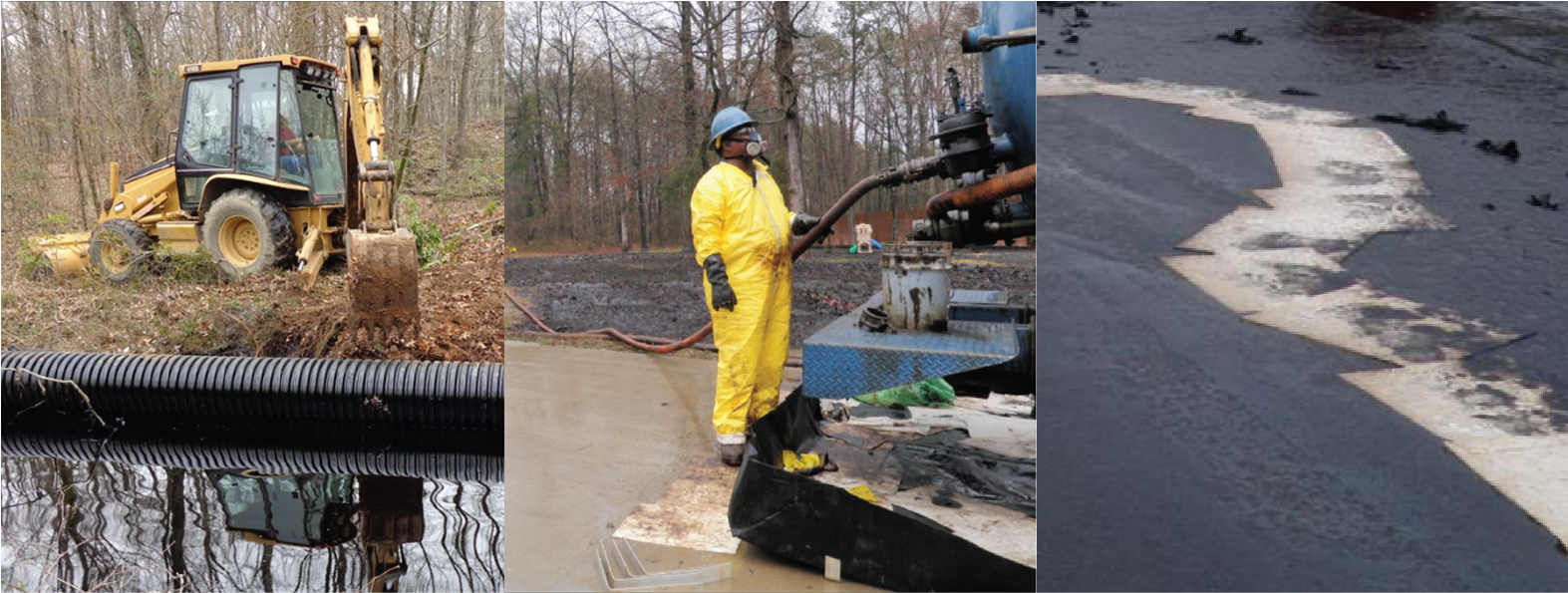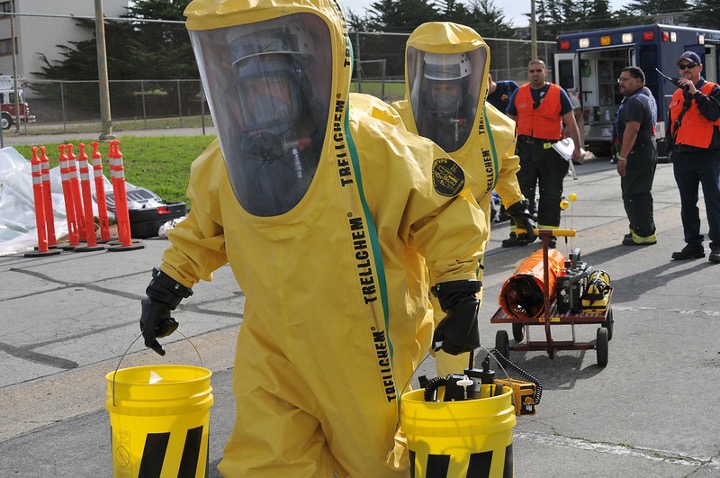The following contamination control techniques are commonly applied – often concurrently – during incident responses on land.51,52
- Containment and recovery. Preventing land-based releases from entering nearby waterways is a high priority in controlling contamination spread. Traditional containment techniques include diversion, diking, ditching, booming, fencing, and damming or berming. These are also performed to keep surface and storm water out of contaminated areas. Contained substances may be recovered for disposal or reuse.
- Neutralization. Physical techniques for neutralization include the use of solidifiers on spilled liquids, which enables the rapid containment and isolation of hazardous substances. Placing the solidifier at run-off points or at the edges of the spill allows the reactant solid to automatically create a barrier that slows or stops the spread of the released material. Chemical techniques include the application of neutralizing substances to acids or alkalis, or stabilizing substances to reactives. Released materials, especially petroleum products, may be removed from the environment by controlled in situ burning (burning in place). In some instances, a controlled burn is the safest way to remove a chemical hazard; as described in the Prologue, this course was chosen to control risks from unstable peroxides following flooding caused by Hurricane Harvey. Over the longer term, biological treatments that result in substance detoxification can be applied.
- Sorption and recovery. Sorbents can be grouped into three main types: Synthetic (polyethylene and polypropylene, nylon, polyester/cotton), organic (peat moss, straw, sawdust, coconut fiber, cork, chicken feathers, ground corn cobs, wood chips, and wool), and inorganic (vermiculite, perlite, glass wool, volcanic rock). Sorbents come as both linear materials, such as pads, rolls, and boom, that can be handled as one unit, and as particulates that are spread over land and then recovered by scraping, raking, or vacuuming. Wide use of sorbents – such as on large releases – is limited by the intensive labor required and the amount of solid waste generated. In some cases, absorbed and adsorbed chemical substances may be recovered.
- Dispersal. In some cases, chemicals can be made non-hazardous to humans by simple dilution with water. Dispersants are chemical agents applied to the spilled material that aid this process. By promoting the formation of very small droplets; these droplets also increase the surface area available to bacteria, accelerating any biodegradation of the chemical.
- Vapor suppression. The release of gases or volatile liquids has the potential to generate vapor clouds that could be toxic and/or explosive. Therefore, the use of vapor suppression products for volatile substances is key for protecting workers and downwind populations. Both temporary and long-term foam-type products can quickly “knockdown” vapors and dusts. Activated carbon adsorption products can be effective for vapor control as well as for soaking up liquid. In some cases, covering the spill area with plastic may be appropriate. Modeling can help predict vapor movement and identify areas at risk; involved populations can then be advised as needed to evacuate, stay indoors, etc.

Personnel initially responding to the scene of a chemical incident need to be trained to a hazardous materials/WMD “awareness” level and if possible, to the “operations” level, as outlined by the National Fire Protection Association (NFPA), in order to rapidly assess the situation and, if possible, take actions to control the spread of contamination.53 Having this training is especially important in the context of response to natural disasters, as the occurrence of an associated chemical incident may not be identified immediately. In an industrial or transportation accident, rapid assessment of the location of storm drains and water sources, wind direction, and gradient of the surrounding terrain can be critical for determining immediate actions for the controlling contamination spread. For example, the impact of a larger-volume incident could be minimized by actions as simple as placing drain protection covers over storm sewer inlets.
First responders may perform limited cleanup activities, provided they follow standard operating procedures and the responder has been adequately trained – in many cases to a minimum of the (HAZWOPER) Hazardous Materials Operations Level.29 For a small release, these activities may include the application of basic containment techniques, that is, methods to restrict the material to its original container (e.g., plugging, patching, overpacking, etc.), and methods to limit the size of the contaminated area (e.g., mist knockdown/ vapor suppression, diversion, diking, booming, absorbing, fencing, and damming).
Properly trained responders with spill kits containing an assortment of absorbents can accelerate the attainment of response and recovery goals for minor incidents. For a small release, the use of granular absorbents, oil absorbent pads, or universal absorbent pads for non-petroleum products may be an easy way to control the spill. These products are readily available and very effective for controlling small chemical releases, provided response personnel understand standard operating procedures for their use and appropriate collection and storage methods for contaminated absorbents. Solidifiers, acid and caustic neutralizers, and activated carbon absorbents are a boon for responders. Once solidified, neutralized, or absorbed, releases substances are less hazardous and easier to handle, transport, and dispose of. Responders arriving early at the scene of transportation accidents involving a chemical release will likely have access to three main types of spill kits; utilization of specific kits depends upon the substance and volume of hazardous material released:54
- Universal or general-purpose spill kits contain absorbents made with activated charcoal or a similar capturing product; these kits are used to cleanup both water-based fluids and hydrocarbons.
- Oil-only spill kits are used to clean-up hydrocarbons only (motor oil, jet fuel, diesel, gasoline, hydraulic oil, etc.) and contain absorbents that repel and float on water.
- HazMat spill kits contain absorbents for fluids such as acids and solvents and will absorb hydrocarbons as well as water-based fluids.
Dedicated HazMat teams with additional containment and cleanup capabilities will augment these early responders later in the response timeline. In major jurisdictions, these teams will follow quickly on the heels of initial responding units.
A Hazardous Materials Response Team can be expected to provide the following functions (see also KPF 2, Recognize and Characterize the Incident):28
- Detect the presence of and identify associated chemical and physical properties of hazardous materials/weapons of mass destruction (WMD).
- Identify and establish control zones after contamination spread.
- Contain and mitigate liquid and vapor leaks through interventions such as neutralization, plugging, and patching.
- Use protocols to collect and label substances and evidence in preparation for transportation.
- Take actions to contain the spread of contamination.

Footnotes
- Occupational Safety and Health. (2008). Hazardous Waste Operations and Emergency Response. Publication 3114-07R.
- Federal Bureau of Investigation. (2018). Joint Criminal-Epidemiologic Investigations Handbook. Centers for Disease Control.
- ExxonMobil. (2014). Oil Spill Response Field Manual. ExxonMobil Research and Engineering Company.
- National Fire Protection Association. (2018). NFPA 472: Standard for Competence of Responders to Hazardous Materials/Weapons of Mass Destruction Incidents. National Fire Protection Association. (2017). NFPA 1072: Standard for Hazardous Materials/Weapons of Mass Destruction Emergency Response Personnel Professional Qualifications.
- U.S. Department of Transportation. (2009, January). Traffic Incident Management in Hazardous Materials Spills in Incident Clearance. Federal Highway Administration.
- International Tanker Owners Pollution Federation (ITOPF) Ltd. (2012). Response to Marine Chemical Incidents. Technical Information Paper 17.


